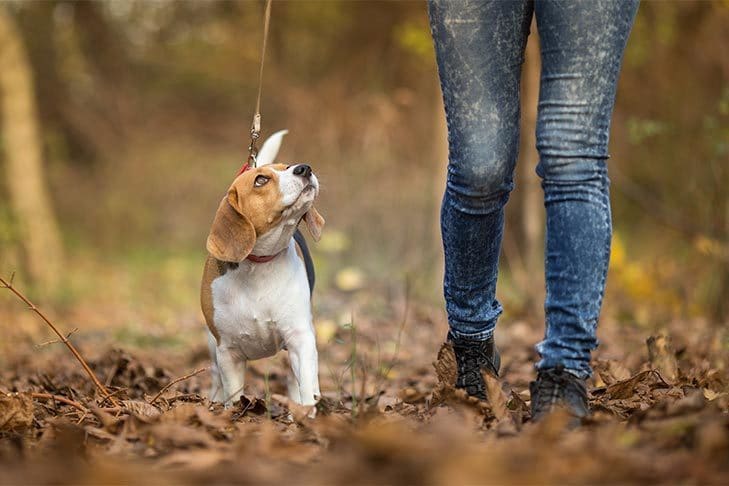Key Points
- Most dogs listen well in quiet environments but some struggle with distractions.
- Getting your dog to ignore distractions and focus on you is crucial for owners.
- “Watch Me”, “Leave It” and “Let’s Go” are good cues to help dogs ignore distractions.
Does your dog only listen at home or training class and ignore you everywhere else? Maybe you suspect your dog is stubborn and only obeys when they feel like it. Well, getting your dog to come when called or to sit and stay is easy in a quiet house. Out and about in a world full of distractions is another situation entirely.
The more likely explanation for your dog’s disobedience is that they’re overwhelmed by the environment and simply can’t focus. There are too many interesting things to explore and dogs need to sniff them all. It’s often not deliberate defiance. You just might not have taught your dog to tune out distractions and concentrate on you.
Build Distractions Slowly
Most dogs can focus in environments where distractions are limited or controlled, like the house or training facility. But you can’t control distractions in the real world. Instead, you must teach your dog to focus on you no matter where you are or what is going on around you. So how do you teach your dog to listen no matter what? It’s simple but requires some planning and management.
The trick to distraction training is to start with a small distraction and slowly build up to larger and more enticing ones. For example, if you have a ball-obsessed dog, don’t start by tossing the ball past your dog’s nose while teaching your dog to stay. Instead, start with the ball on the ground several feet away while asking for a stay. If your dog can handle that, gradually move the ball closer during the next training session. Next, hold the ball. Then, toss it in your hand. As a final test, toss the ball past your dog. This type of training may take weeks to progress through but will serve to build your dog’s confidence as they get better and better.
The key point is to set your dog up for success. If it seems too easy, then you’re probably at the right level of distraction. Remember that every time your dog ignores you in favor of the distraction, your dog is practicing ignoring you. That’s not a habit you want to build. On the other hand, every time your dog is successful at doing what you ask, your dog learns the value of concentrating on you.

Distraction Training Tips
Don’t just manage the distractions, manage the environment too. It’s no good working on low-level distractions if a group of kids is going to burst into the room at any second. For some dogs, even high-value treats or toys can be too exciting. Think about any possible factor that could grab your dog’s focus and control it as best you can. Only when your dog has mastered the toughest distractions in training are you ready to take on the unpredictability of the real world.
When you’re doing distraction training, leave distance and duration alone. Known as the three Ds of dog training, each of these acts as a different challenge for your dog. So, when you’re training stay with the tennis ball, don’t add in walking away from your dog (distance) and don’t ask for a stay of several minutes (duration). That’s simply too many challenges at one time. Stay close and keep behaviors short so the distraction is the only issue your dog has to face.
Match Rewards to Distraction Levels
When teaching your dog to handle distractions, understand that you are competing with the environment. You need to offer your dog a better choice. Dogs repeat rewarding behaviors, so if sniffing the tree trunk and ignoring you is more rewarding than coming when called, your dog will choose the tree trunk every time. For most dogs, that would certainly be the case if all you were offering was a bit of kibble.
But what if you upped your game and rewarded your dog with a chunk of chicken breast or a game of tug-of-war? That would make your dog think twice about choosing the tree trunk over you the next time around. If you’re the most exciting thing in the environment and provide the best rewards, your dog will be much more likely to ignore the world and listen to you.
Every dog has a different hierarchy of rewards. In other words, some will do anything for freeze-dried liver and others want their tennis ball more than food. Learn what your dog loves best and use that hierarchy to match the level of distraction you’re competing with. The top items should go with the hardest challenges. Save the boring stuff for the minor distractions only.
In fact, you can even use the hardest distractions as rewards themselves. If squirrels are your dog’s favorite thing, let him chase one after he lies down to reinforce obeying the down cue in the presence of a squirrel. This is known as the Premack Principle, and it teaches dogs that giving you what you want will get them what they want.

Watch Me, Leave It, and Let’s Go
Even with the best training program, there will still be times when your dog is caught up in a new smell or activity and loses concentration. You can’t train for every scenario. That’s where “Leave It,” “Watch Me,” and “Let’s Go” come in handy.
“Leave It” teaches your dog when something is off-limits. Use this cue to prevent your dog from becoming wrapped up in a distraction. “Watch Me” tells your dog to make eye contact with you. This is a great way to switch your dog’s focus from a distraction back to you. And finally, “Let’s Go,” often used in place of “heel”, is great on walks to tell your dog it’s time to move on and get going.


